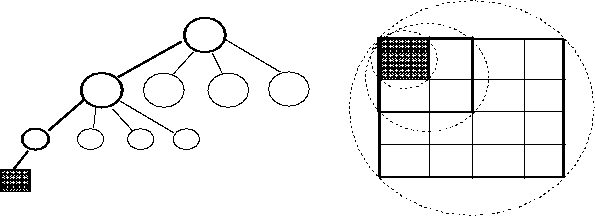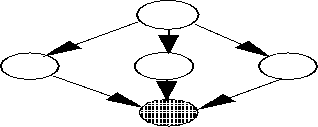
Spatial Hierarchy Balanced with Scene Complexity
The major real-time database traversals are the cull and collision traversals. Both benefit by having a database that is spatially organized, or is coherent in world space. These traversals eliminate parts of the scene graph based on bounding geometry. If a database hierarchy is organized by grouping spatially near objects, then entire sub-trees can be easily eliminated by the bounding geometry of a root node. If most nodes have bounding geometry that covers much of the database, then an excessive amount of the database will have to be traversed.

FIGURE 13. Scene-graph with Spatial Hierarchy
It is additionally helpful to have a hierarchy based on square areas so that simple bounding geometry, such as bounding spheres, can be used to optimize the traversal test.
The amount of hierarchy put in the database should balance the traversal cost of nodes with the number of children under them. A node with few children will be able to eliminate much of the database in one step. However, a deep hierarchy might be expensive to maintain as objects change and information must be propagated up the tree.
Instancing in a database is where multiple parents reference a single instanced child which allows you to make performance/memory trade-offs.

FIGURE 14. Instanced Node
Instancing saves memory but prevents a traversal from caching traversal information in the child and also prevents you from flattening inherited matrix transformations. To avoid these problems, IRIS PerformerTM provides a compromise of cloning where nodes are copied but actual geometry is shared.
The amount of geometry stored under a leaf node will affect all of the traversals, but there is a performance trade-off between the spatial traversals and the drawing task. Leaf nodes with small numbers of polygons will provide a much more accurate culling of objects to the viewing frustum, thus generating fewer objects that must be drawn. This will make less work for the rendering task; however, the culling process will have to do more work per polygon to evaluate bounding geometry. If the collision traversal needs to compute intersections with actual geometry, then a similar trade-off exists: fewer polygons under a leaf node means fewer expensive polygon intersections to compute.
Modeling to the Graphics Pipeline
The modeling of the database will directly affect the rendering performance of the resulting application and so needs to match the performance characteristics of the graphics pipeline and make trade-offs with the database traversals. Graphics pipelines that support connected primitives, such as triangle meshes, will benefit from having long meshes in the database. However, the length of the meshes will affect the resulting database hierarchy and long strips through the database will not cull well with simple bounding geometry.
Objects can be modeled with an understanding of inherent bottlenecks in the graphics pipelines. Pipelines that are severely fill-limited will benefit from having objects modeled with cut polygons and more vertices and fewer overlapping parts which will decrease depth complexity.

FIGURE 15. Modeling with cut polygons vs. overlapping polygons
Pipelines that are easily geometry or host limited will benefit from modeling with fewer polygons.
There are a couple of other modeling tricks that can reduce database complexity. One is to use textured polygons to simulate complex geometry. It is especially useful if the graphics subsystem supports the use of alpha textures where a channel of the texture marks the transparency of the object. Texture can be made as cut-outs for things like fences and trees. Textures are also useful for simulating particles, such as smoke. Textured polygons as single-polygon billboards are additionally useful. Billboards are polygons that are fixed at a point and rotated about an axis, or about a point, so that the polygon always faces the viewer. Billboards are useful for symmetric objects just as light posts and trees, and also for volume objects such as smoke. Billboards can also be used for distant objects to save geometry. However, the managing of billboard transformations can be expensive and impact both of the cull and draw processes.
3D Database modeling techniques like these have been in use for a long time in Visual Simulation applications.